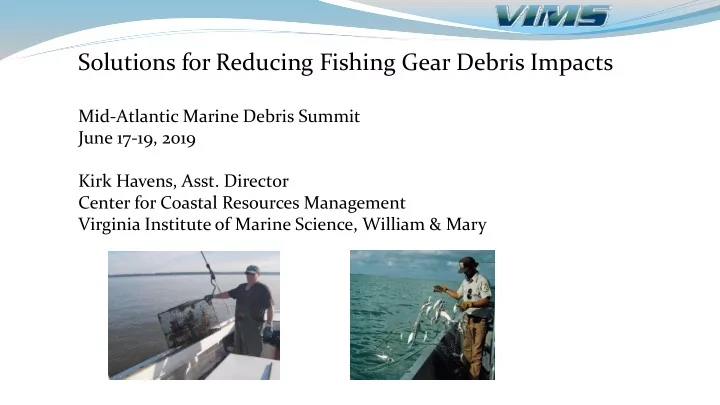

Solutions for Reducing Fishing Gear Debris Impacts Mid-Atlantic Marine Debris Summit June 17-19, 2019 Kirk Havens, Asst. Director Center for Coastal Resources Management Virginia Institute of Marine Science, William & Mary
NOAA Marine Debris Program. 2015 Report on the impacts of “ghost fishing” via Virginia Institute of Marine Science, Marine Debris Location and Removal Program derelict fishing gear. Silver Spring, MD. 25 pp
From: Sylwia Migdał , WWF Poland Third Workshop on implementation of the Regional Action Plan on Marine Litter. 2018.
Image: Lucie Machin/University of Exeter
Lots of work on reducing bycatch in nets (much of that work is applicable to reducing bycatch of lost, abandoned, or discarded nets) [Workshop on Sea Turtle and Atlantic Sturgeon Bycatch Reduction in Gillnet Fisheries , 2013, ASMFC; Eric Gilman – Pelagic Ecosystems Research Group, Honolulu; NOAA Marine Debris Program: Impact of “Ghost Fishing” via derelict gear] • Increasing net visibility – coloration, contrasting panels, acoustic (species specific) • Reducing breaking strength of mesh (loss of catch); biodegradable filaments • Raising the footrope (species specific) • Reducing vertical height of net From Milliken and Wang. 2013. National Marine Fisheries Service and Atlantic States Marine Fisheries Commission. 2013. Workshop on Sea Turtle and Atlantic Sturgeon Bycatch Reduction in Gillnet Fisheries. Jan 22-23, 2013, Ocean City, MD. 48 pp.
Some of the previous modifications are not applicable for nets that have broken free of moorings and are free-floating.
J. Benavides. The negative impacts of gillnet fishing on marine ecosystems: a scientific review. NOAA Marine Debris Program Use of biodegradable driftnets to prevent ghost fishing, S. Kim et al.
Derelict traps / pots Virginia Institute of Marine Science, Marine Debris Location & Removal Program William & Mary, R. Chambers
Over 34,000 removed
James DelBene J. DelBene. Marine Pollution Bulletine. 2019. J. DelBene. Marine Pollution Bulletine. 2019.
Mechanisms designed to fall away or break away or spring open or shut (ferrous hog rings, rot cord, etc) do not work well due to biofouling growth once lost .
biopolymerr Mechanisms to ‘disarm’ pots once lost to prevent continued ‘ghost fishing’ by creating a hole. Untreated wood Jute twine Cotton twine
Polyhydroxyalkanoate (PHA) Naturally occurring bacteria produce PHA as small granules to store energy. When PHA comes into contact with aquatic environments, resident bacteria recognize it as food and consume it breaking it down into byproducts of water and CO2. As a result of research mentioned in this talk, researchers named as inventors on patents owned by the College of William & Mary may receive royalties on sales of any licensed products. The terms of this arrangement have been reviewed and approved by the College of William and Mary in accordance with its conflict of interest policies. Proceeds donated to charity
New Jersey All commercial crab pots sold, offered for sale, or possessed on marine waters must include a biodegradable panel or other mechanism which is designed to create an opening to allow the escape of crabs or other marine organisms after a pot has been abandoned, or lost, The panel shall be constructed of, or fastened to the pot with one of the following materials: wood lath; cotton, hemp, sisal, or jute twine no greater than 1/16 inch in diameter; or non-stainless, uncoated ferrous metal not greater than 3/32 inch in diameter; Florida & Texas The trap must have a degradable panel larger than 3 inches by 6 inches. Types of degradable panels include: untreated jute twine, non-coated steel wire measuring 24 gauge or thinner, untreated pine dowel no larger than 2 inches in length by 3/8 inch in diameter or untreated pine slats no thicker than 3/8 inch
Ruling Robot Falcons Young Scientists: Up to a Marine Debris Challenge Every year, school students (ages 9 to 16) engage in researching solutions to a real-world problem through the “FIRST LEGO League Challenge (FLL).” In 2015, the international challenge selected by FLL was TRASH! More than 230,000 students across the globe applied science, technology, engineering, and math concepts (STEM), to solve a trash-related problem of their choosing. In Virginia, one of the regional winning teams – The Ruling Robot Falcons – choose balloon litter. The young researchers created a balloon that could biodegrade completely and quickly while still being able to float when filled with helium.
Questions? Subscribe to e-Tidings —VIMS’ monthly e -newsletter — to stay “ in the know ” about our upcoming public events and latest research. Text “VIMS” to 22828 to register now! Free subscription New issue each month Cancel anytime www.vims.edu Rhymes with Orange, 7-27-2014
Recommend
More recommend